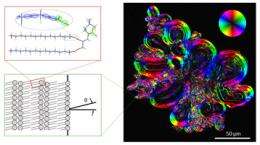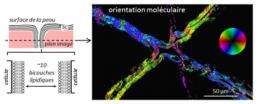3D mapping of lipid orientation in biological tissues such as skin

A non-invasive method that makes it possible to observe in situ how assemblies of lipids are oriented in biological tissues, and which does not require any labeling or preparation, has been developed by physicists from the Laboratoire d'Optique et Biosciences (CNRS / Inserm / École Polytechnique). This work, published on the 14 January 2013 in the online journal Physical Review X, should enable the detection and characterization of certain pathologies associated with molecular disorders in the skin or in the nervous tissue.
Multilamellar assemblies of lipids (fats) play a key role in certain physiological functions, not just within the skin (which serves as a protective barrier against external aggressions) but also in the way neurons function. The disorganization of these assemblies is often linked to serious pathologies. However, the techniques normally used to determine the arrangement of molecules, such as X-ray scattering or nuclear magnetic resonance, are not suitable for studying intact biological tissues with good cellular resolution. In addition, they often require labeling and/or significant sample preparation.
First developed in the 1990s, multiphoton microscopy allows intact biological tissue to be observed in three dimensions with sub-cellular resolution at depths exceeding several hundred micrometers. Researchers from the Laboratoire d'Optique et Biosciences have identified a new indicator, known as P-THG (polarized third-harmonic generation), which is sensitive to molecular order in multi-layer lipid assemblies. Thanks to this optical contrast source, it is now possible to map the general orientation and degree of alignment of lipid assemblies in three dimensions and also to observe their possible disorganization. This novel multiphoton microscopy technique thus provides a non-invasive tool for probing molecular alignment in situ in biological media.

This approach enables scientists to map, with unparalleled sensitivity and contrast, the organization of lipids in human skin biopsies without prior preparation or labeling. This work lays the foundations for future developments in multiphoton microscopy as a method for measuring molecular order in intact biological media and opens the way to potential novel applications for detecting and studying the early stages of pathologies linked to molecular disorders.
More information: Probing ordered lipid assemblies with polarized third-harmonic generation microscopy. Maxwell Zimmerley, Pierre Mahou, Delphine Débarre, Marie-Claire Schanne-Klein and Emmanuel Beaurepaire. Physical Review X, 14 January 2013. dx.doi.org/10.1103/PhysRevX.3.011002
Journal information: Physical Review X
Provided by CNRS




















